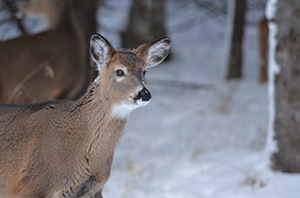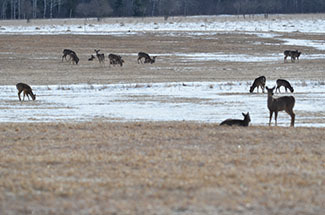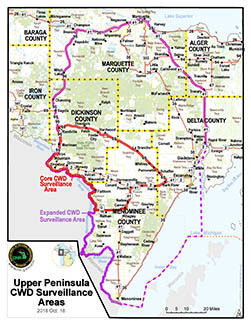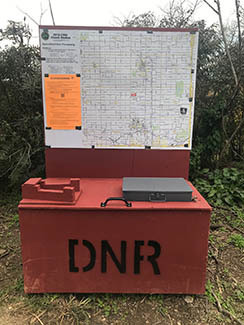Continuing the fight against chronic wasting disease
By JOHN PEPIN
Michigan Department of Natural Resources
When a 4-year-old doe was confirmed positive for chronic wasting disease in Dickinson County in October, it was the first time this deadly disease affecting portions of Michigan’s white-tailed deer herd had been found in the Upper Peninsula.
For many, including hunting groups and government officials, who had been involved in cooperative efforts over the past few years to inform the public and prepare hunters for CWD’s potential arrival, this eventual detection was anticipated.
However, for many others, news of the presence of the disease was unexpected and shocking.
 “This was no longer obscure and distant, something affecting only parts of the state below the Mackinac Bridge,” said Terry Minzey, Michigan Department of Natural Resources U.P. regional wildlife coordinator. “This was now here in their backyard.”
Chronic wasting disease is a fatal nervous system disease found in animals from the family Cervidae, including deer, moose and elk. The disease attacks the brain of infected animals, creating small lesions, which result in neurologic symptoms. The disease is always fatal in animals that contract it.
The announcement had come five weeks before the Nov. 15 opening day of the firearm deer hunting season, followed by an initial flood of questions from hunters, farmers, meat processors and others.
Many people wanted to know whether the DNR had checked to see what other states had done to confront CWD. In fact, Michigan is recognized as a leader in battling the disease.
“While chronic wasting disease might be new to some people, it’s by no means new to the DNR,” said Russ Mason, DNR Wildlife Division chief. “Since 2015, when the first free-ranging deer was found with CWD in Ingham County, we’ve been taking action based on our surveillance and response plans developed in 2012.”
In the U.P., DNR wildlife biologists had been conducting disease testing in Michigan counties bordering Wisconsin, testing the heads of deer collected from roadsides, found dead or shot on farms through deer damage shooting permits.
|
 “It was part of this testing surveillance effort we had been working on for about three years that led to the infected doe being discovered,” said Craig Albright, the DNR Wildlife Division’s U.P. field operations manager. “There have also been publicity and information efforts, including billboards erected, television programs and radio spots produced, and fliers and other materials developed.”
A U.P. CWD Task Force created roughly three years ago by Michigan Natural Resources Commissioner J.R. Richardson of Ontonagon was convened to help hunting groups, lawmakers and others understand CWD, its effects on deer and measures – such as mandatory deer testing or restricting of baiting and feeding – that might potentially be ordered should CWD arrive in the region.
The task force drafted recommendations to the DNR and NRC, suggesting measures taken in the U.P. should vary from those implemented in Lower Michigan, based on a variety of differences in geographic and deer-herd dynamics.
“The task force delegates also serve as messengers to their members and constituencies,” said NRC Chairwoman Vicki Pontz. “Their getting out ahead of everything was very helpful. Their proactive involvement has been extremely important.”
|
A webpage containing multiple tools for CWD education was created at michigan.gov/cwd.
In the fall of 2017, a CWD symposium was held in Lansing, bringing experts together from around the world to talk about the latest science on the disease and best management practices.
 Not long after those discussions, which were taped and provided on the webpage, the Michigan Natural Resources Commission and the DNR announced the creation of a nine-member CWD Working Group.
“This group was charged with developing recommendations on additional actions to take to mitigate substantially CWD in Michigan,” Mason said. “They reported their initial findings in January.”
For the next six months, the NRC and DNR took to the road to solicit information from hunters and others on deer regulations and management of CWD in Michigan.
“We collected feedback at 11 public engagement meetings held in cities across the state,” said Sara Thompson, a DNR wildlife biologist and CWD logistics coordinator. “We also gathered comments from the public through an online survey and comment periods at NRC meetings and other venues.”
Having collected and considered this public input, gathered scientific data and evaluated the CWD management approaches of other states, the DNR presented a series of recommendations to the NRC in June.
|
 In August, the NRC approved several deer hunting regulations aimed at slowing the spread of chronic wasting disease.
Two months later, when the deer confirmed with CWD was discovered in Waucedah Township in Dickinson County, the DNR took several immediate steps to get a CWD response plan on the ground and moving.
“The first thing we needed to do was to get a lot more deer heads to test to find out how far the disease may have spread,” Minzey said. “To do this we set up two concentric surveillance areas centered around the site of the infected deer.”
A roughly 10-mile-radius core surveillance area – encompassing 661 square miles – was created. Outside the core CWD surveillance area, the DNR created a 75-mile-radius expanded surveillance area.
The DNR set goals to test 600 deer heads for CWD from the core surveillance area and 300 more from the wider area.
Landowners located within 2 miles of the infected doe (index case) were offered free disease control permits to shoot deer on their properties. Private land antlerless deer licenses were also available in select deer management units.
“We urged hunters to test their deer voluntarily,” Albright said. “We needed to get a statistically viable sample large enough to help us reliably predict our conclusions about how far the disease has spread.”
|
The DNR increased hours at check stations within the surveillance areas and constructed several drop boxes for after-hours deer head submissions.
“The response from hunters was tremendous,” Mason said. “We were able to meet and surpass our surveillance goals.”
As of Dec. 7, lab staffers have tested 758 deer from the core surveillance area and 675 from the expanded surveillance area, with no additional CWD-suspected positive deer found.
“Numerically, we reached our goals, but geographically, we have some gaps we need to fill to gain a better understanding of the situation,” Minzey said.

Disease lab personnel produced a monumental effort to process thousands of deer throughout the year.
At the DNR’s Wildlife Disease Laboratory, personnel have tested nearly 22,000 deer for CWD this year.
Meanwhile, since July, just over 16,000 deer from across the state have been tested for CWD at the Michigan State University Veterinary Diagnostic Laboratory – a pace set to break last fiscal year’s total of 19,818.
To efficiently handle high-volume CWD testing without impacting turnaround time of other tests, the veterinary disease lab created a dedicated CWD testing area this hunting season and trained additional personnel to increase testing capacity.
The laboratory began planning for the 2018 hunting season several months in advance, due to the anticipated increase in surveillance and submissions from hunters.
“Our partnership with the Michigan Department of Natural Resources, especially our close relationship and proximity to the Wildlife Disease Laboratory co-located in our building, has been essential to providing the support needed for the DNR’s surveillance efforts,” said Rachel Reams, lab director. “Regular updates from them helped us to plan, purchase adequate supplies and arrange for staffing to handle the number of samples this year. Even on the busiest days, when our technicians were processing up to 1,200 samples, they felt equipped to handle the volume and turnaround time.”
No new regulation changes were imposed for the 2018 hunting seasons in the U.P., following the October CWD detection. A decision on supplemental feeding of deer for this winter was postponed pending results of the surveillance effort.
“In the weeks ahead, we will be looking at the path forward to determine whether any emergency measures are necessary that would produce changes to hunting or feeding regulations for the U.P.,” Pontz said. “We are currently in the second year of a three-year cycle for deer hunting regulations. We wouldn’t regularly consider changing anything until after three years.”
Whatever is eventually decided, those decisions will be made with the latest science, the informed recommendations of DNR wildlife biologists and the continued valuable input of hunters, the U.P. CWD Task Force and the general public.
“We’ve all worked together as a successful team thus far,” Mason said. “The best way forward is to maintain that cooperation to help keep Michigan recognized among the country’s leading states in battling this disease.”
Learn the answers to some frequently asked questions about chronic wasting disease.
Visit the CWD webpage for the latest updates, video lectures from the symposium, surveillance area maps, the CWD response plan and more at michigan.gov/cwd.
To learn more about the CWD-testing process, watch a short DNR video.
Check out previous Showcasing the DNR stories in our archive at michigan.gov/dnrstories. To subscribe to upcoming Showcasing articles, sign up for free email delivery at michigan.gov/dnr.
|
/Note to editors: Contact: John Pepin, Showcasing the DNR series editor, 906-226-1352. Accompanying photos and a text-only version of this story are available below for download. Caption information follows. Credit Michigan Department of Natural Resources, unless otherwise noted.
Text-only version of this story.
Box: Self-service drop boxes like this one are available for 24-hour deer head drop-off.
Buck: A Michigan white-tailed buck is shown.
Check: Michigan Department of Natural Resources wildlife biologist Brian Roell, left, and wildlife technician Caleb Eckloff get ready to weigh a deer at the Marquette DNR check station.
Field-1 and Field-2: Deer stand in a field in Mackinac County.
Goals Map: A map shows the Michigan Department of Natural Resources’ deer head testing goals for 2018 across Michigan.
Surveillance Map: A map shows the two chronic wasting disease surveillance areas set up in the Upper Peninsula around Waucedah Township in Dickinson County, where a 4-year-old doe tested positive for CWD in October.
Winter: A white-tailed deer is shown in winter in Marquette County./
|